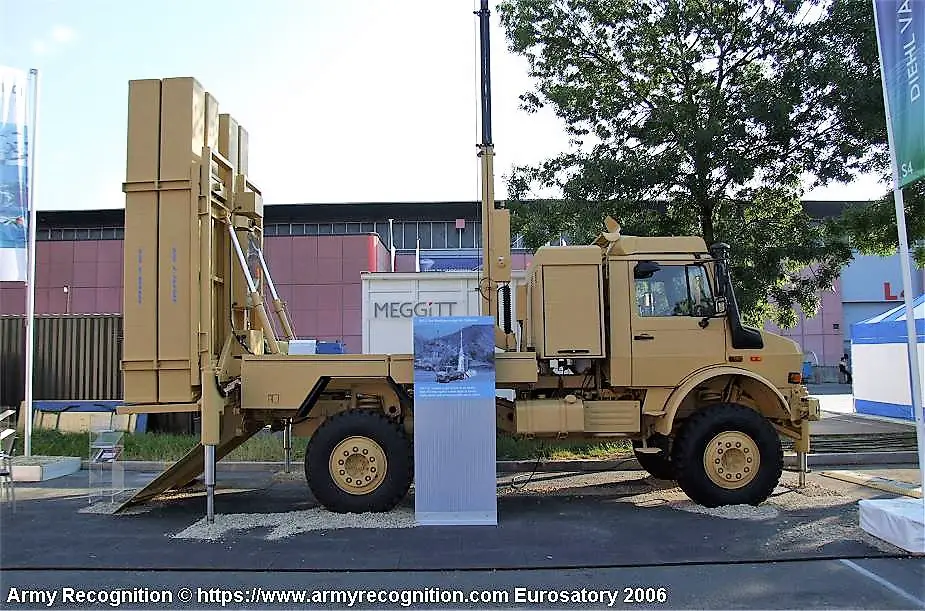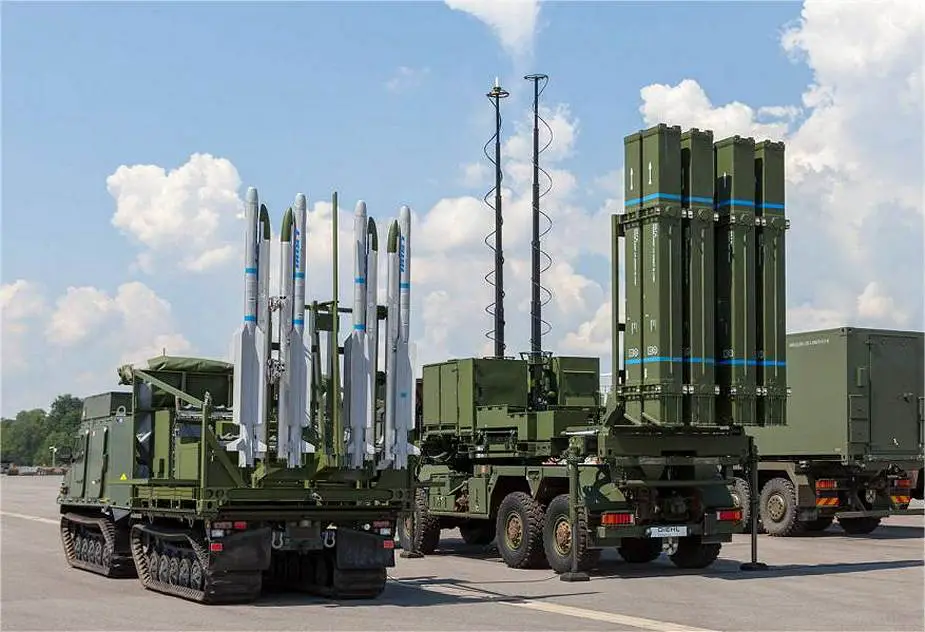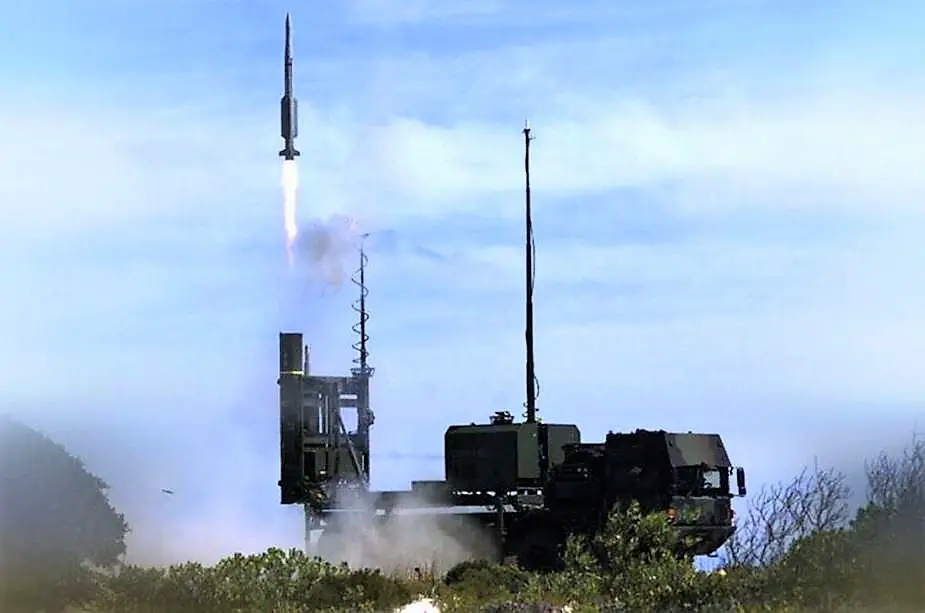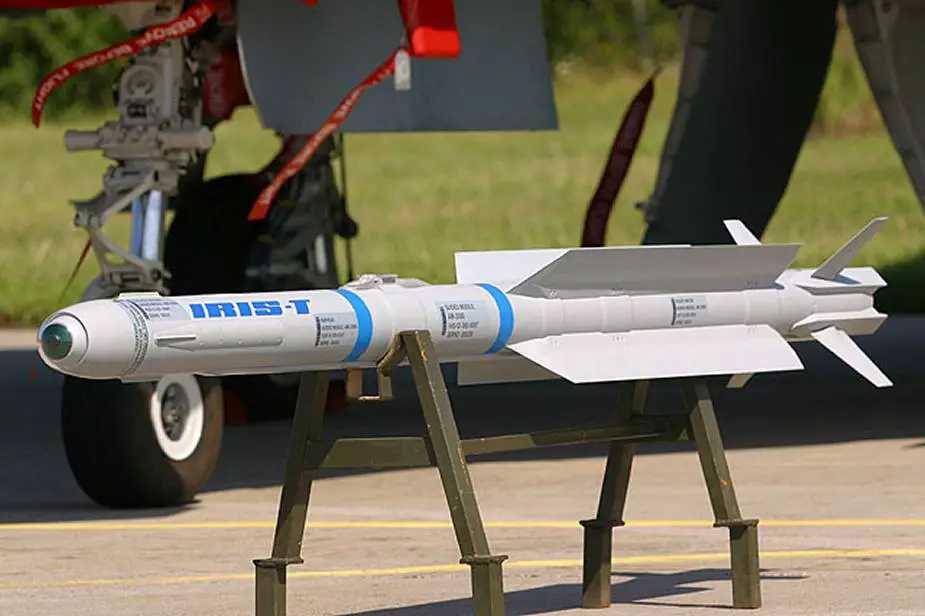- Army
- Conflicts in the world
- Israel - Iran conflict 2025
- Pakistan - India Conflict 2025
- Russia Ukraine War 2022
- Libya conflict day by day
- HAMAS - Israel War 2023
- Operation Serval in Mali French Army
- Sangaris operation Central African Republic
- Sangaris opération militaire République Centreafrique
- Ukraine - Russia conflict
- Syria conflict news
- Defence & Security Industry Technology
- Armies in the world
- Analysis Defense and Security Industry
- Conflicts in the world
- Navy
- Air
Ukraine Army receives first IRIS-T air defense system from Germany
In a tweet posted on Tuesday, October 11, Ukrainian Defense minister Oleksii Reznikov wrote: "A new era of air defence has begun in Ukraine. IRIS-Ts from Germany are already here. U.S. NASAMS are coming. This is only the beginning. And we need more. No doubt that Russia is a terrorist state. There is a moral imperative to protect the sky over Ukraine in order to save our people". "And personal thanks to my colleague German Minister of Defence Christine Lambrecht for her partnership and a strong commitment to supporting Ukraine. We will win".
Follow Army Recognition on Google News at this link

German IRIS-T air defense missile system mounted on a Mercedes-Benz Unimog. (Picture source: Army Recognition)
On June 1, 2022, Army Recognition reported that German Chancellor Olaf Scholz announced that Germany will provide Ukraine with the German-made IRIS-T air-dense missile system manufactured by the company Diehl Defence. These IRIS-T air defense systems are manufactured specifically for Ukraine, and, as such, they are not in service with the German army, added the German Ambassador to Ukraine Anka Feldhuzen. The German army itself has got missiles of the Iris-T type, but not the complete surface-to-air system: it fires the missiles from its Tornado or Eurofighter aircraft.
The IRIS-T SLM is a mobile infrared homing surface-to-air defense missile system intended to counter and destroy aerial targets such as aircraft, helicopters, cruise missiles, guided weapons, air-to-surface missiles, anti-ship missiles, anti-radar rockets, and large-caliber rockets. It can be also used to destroy unmanned aerial vehicles at very short and medium distances.
Based on the IRIS-T, the German company Diehl Defence has developed the IRIS-T SL, a land-based version. The missile can be launched from a vertical launcher station which can be mounted on wheeled or tracked combat vehicles. The IRIS-T SLM is the medium-range version of the IRIS-T SL. The missile of the IRIS-T SLM has a maximum firing range of 40 km and an altitude of up to 20 km. The command and fire control vehicle is used to conduct the analysis of the threats and transmit firing orders to the launcher units. The vehicle is connected via a network to superior combat operation centers. The multi-function radar is able to detect aerial threats at a maximum range of 200 km on 360°. It can detect up to 500 objects at the same time.
For its part, the United States has promised NASAMS surface-to-air missile systems: two for delivery in the coming weeks or months, and six others as part of longer-term assistance.

The launcher weapon station of the Iris-T missile can be mounted on tracked or wheeled chassis. (Picture source Dhiel Defense)

Launching of an IRIS-T air defense missile (Picture source: Twitter account of Ukrainian Defense miniter Oleksii Reznikov)

IRIS-T displayed at the ILA 2006 expo in Berlin, in front of a German Luftwaffe Eurofighter (Picture source: Wikipedia)
Russian Buk to counter German IRIS-T in Ukraine
TASS - ANALYSIS: AIR-DEFENSE
MOSCOW, October 12. /TASS-DEFENSE/. Germany has handed over to Ukraine the first of the four modern IRIS-T SLM air defense systems, Der Spiegel reported. The other three systems are likely to be shipped to Kiev next year.
TASS compared the German launcher with Russian antiaircraft systems engaged in Ukraine.
IRIS-T
Medium-range Infra Red Imaging System Tail/Thrust Vector-Controlled Surface Launched Medium Range (IRIS-T SLM) was designed by German Diehl BGT Defence Company. The design began in 2007 and trials were completed in 2014.
IRIS-T SLM fires upgraded air-to-air missiles with an infrared homing warhead operating by the fire-and-forget principle. The producer said the warhead has an extremely high resolution, selects targets and is resistant to heat traps. The missile is highly maneuverable. The range is 40 km and the altitude is 20 km.
IRIS-T SLM has multirole radar TRML-4D of Hensoldt Company. It detects targets at a distance of 250 km and an altitude of 40 km and provides the parameters of 1500 air objects at a time. The radar detects a fighter jet at a distance of 120 km and a supersonic missile at 60 km. The complex can have passive radar Twinvis that detects targets by signals reflected from electromagnetic emission sources. It simultaneously tracks 180 objects.
The launcher has eight antiaircraft missiles in transportation-launch containers.
Buk
Russian Buk of Almaz-Antey is the closest weapon to IRIS-T SLM. The latest Buk-M3 modification is actively engaged in Ukraine. Besides aerodynamic targets, it intercepts ballistic missiles, including Tochka-U.
The radar of the Viking complex detects targets at a distance of 200 km. The antiaircraft missile destroys them at a distance of 65 km and an altitude of 25 km, which is much more that the German system can do. Buk-M3 can down stealth aircraft, helicopters, cruise missiles, tactical ballistic missiles. It is also effective against ground and sea radiocontrast targets due to the 70-kg warhead.
Buk can defend itself from American HARM antiradar missiles by using passive radars and by transmitting the information about the threat to short-range Tor-M2 complex, which specializes in short-range interception and can defend Buk.
One Buk can simultaneously attack six targets. It carries eight launchers with 12 antiaircraft missiles or four self-propelled launchers with six missiles in transportation-launch containers. The complex can carry 120 missiles to repel a massive strike with modern air weapons. Open sources said the latest modifications of Buk missiles can be armed with active radar homing warheads operating by the fire-and-forget principle. Buk can effectively down aircraft at super low altitudes and major distances. The launcher is armored to protect the crew and electronics against bullets and fragmentation.
To extend the destruction range, Buk can be assisted by 9A383E launcher (export option of Viking) with antiaircraft 9M83ME missiles. They hit targets at a distance of 120 km and an altitude of 30 km. IRIS-T SLM can also fire long-range western missiles due to standardized exchange protocols. However, there are no compatible complexes in Ukraine.
Experts say
Military experts have numerous questions to the German launcher, which has not been engaged in combat yet. “The system does not have guided antiaircraft missiles. It fires air-to-air missiles, which are adapted for the ground launcher,” Editor of the Arsenal of the Fatherland journal Alexey Leonkov told TASS.
“The launcher was designed since 1990s together with Italy, Sweden, Greece, Norway and Canada. Germany expects the complex to be ready by 2023,” he said and doubted that it would stand up to the declared characteristics.
“IRIS-T has been upgraded. When the Germans demonstrated it, it became clear that it is inferior to our Pantsir and Buk. The Germans upgraded the missile and increased the range to 40 km thus making IRIS-T a medium-range weapon,” he said.
The radar operates in the centimeter band and sees targets at a distance of 250 km. “There is no information how many targets it can track. They claim it can detect up to 1500 targets. It is unclear whether it is the total number or whether they speak about civilian objects,” Leonkov said.
Experts believe that the infrared homing warhead of IRIS-T SLM is sensitive to heat traps and can be blinded by onboard defense despite claims about its jam-resistance. Most Russian jets, helicopters and bombers engaged Ukraine are equipped with Vitebsk jammers that detect a guided antiaircraft missile and jam it by a powerful laser beam that hits the optical, infrared or thermal homing warhead,” artillery and missile forces and war veteran Alexey Sakantsev told TASS.
Vitebsk onboard defense was designed by Ekran Institute in Samara to protect airplanes and helicopters against guided missiles and manpads. It produces optical and radio disturbances. The military said Vitebsk increased helicopter survivability in Ukraine. All gunships are now equipped with it. The Radioelectronic Technologies Company is upgrading Vitebsk according to combat engagement experience.
Izvestia military observer Alexey Ramm believes IRIS-T cannot fight low-altitude maneuvering targets because it fires air-to-air missiles rather than antiaircraft missiles. “The missile adjusts the flight by GPS signal and switches on the infrared homing warhead close to the target. Therefore, electronic warfare and passive traps can pose a major problem for IRIS-T missiles,” he said.
Besides, the small number of German launchers is insufficient for the long frontline in Ukraine. “The IRIS-T SLM story looks more like frontline trials rather than an attempt to help Ukraine. Many western countries are sending new weapons to Ukraine to see how they operate in real combat. The whole operation is an excellent range for weapon trials,” Sakantsev said.
END OF TASS PRESS NEWS


























